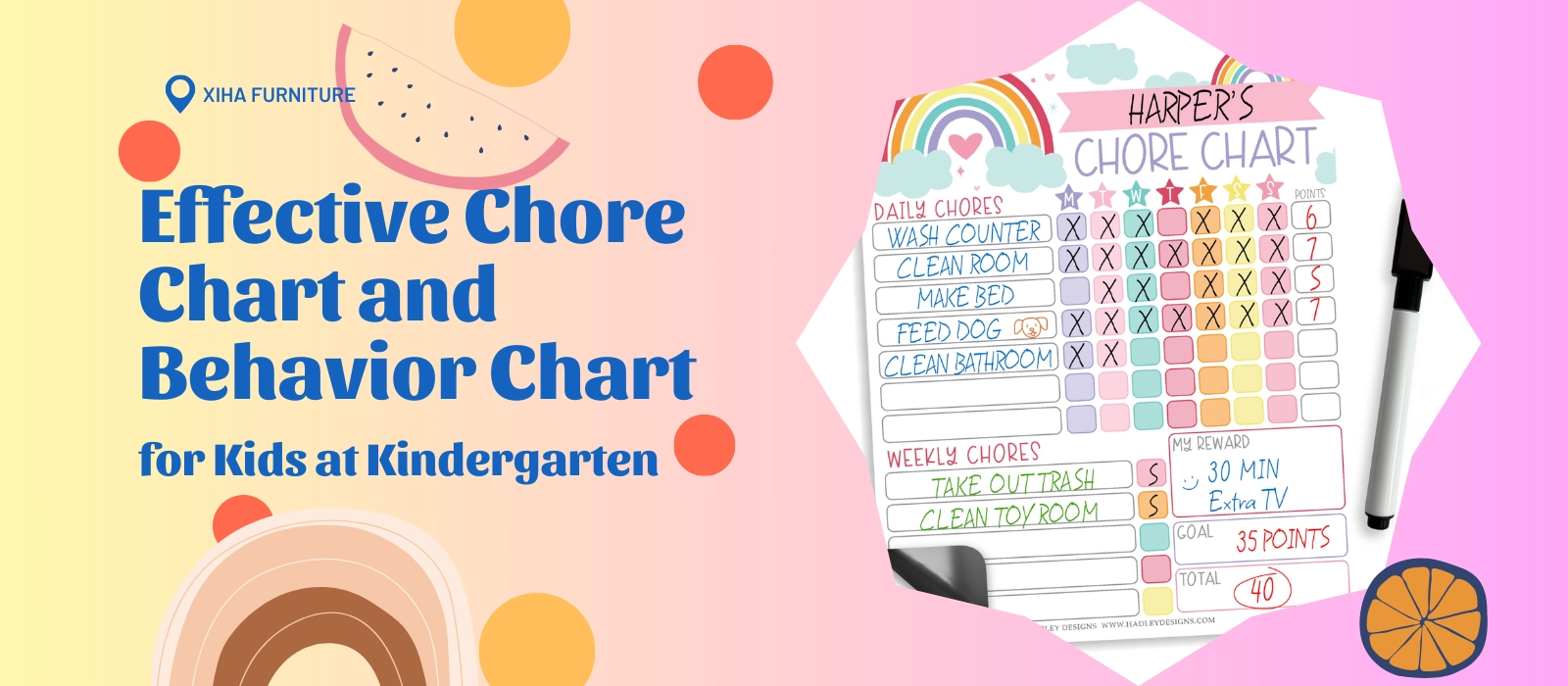Are you struggling to manage daily routines in your kindergarten classroom? Do your students constantly forget to clean up, follow rules, or respect each other? Are you looking for a structured way to track progress and reinforce good behavior without constant reminders or raised voices?
Chore charts and behavior charts for kids play a vital role in establishing structure, promoting responsibility, and encouraging positive reinforcement in kindergarten. These visual tools not only help young children understand expectations, but also motivate them to complete tasks and display good behavior through tangible rewards like stickers, stars, or praise. Implementing chore charts and behavior charts in your classroom builds consistency, teaches self-management, and supports emotional development during a child’s formative years.
If you’re an educator or administrator searching for an effective classroom management system tailored to early learners, you’re in the right place. This guide will walk you through everything you need to know about setting up, customizing, and maximizing the impact of chore charts and behavior charts in your kindergarten environment.
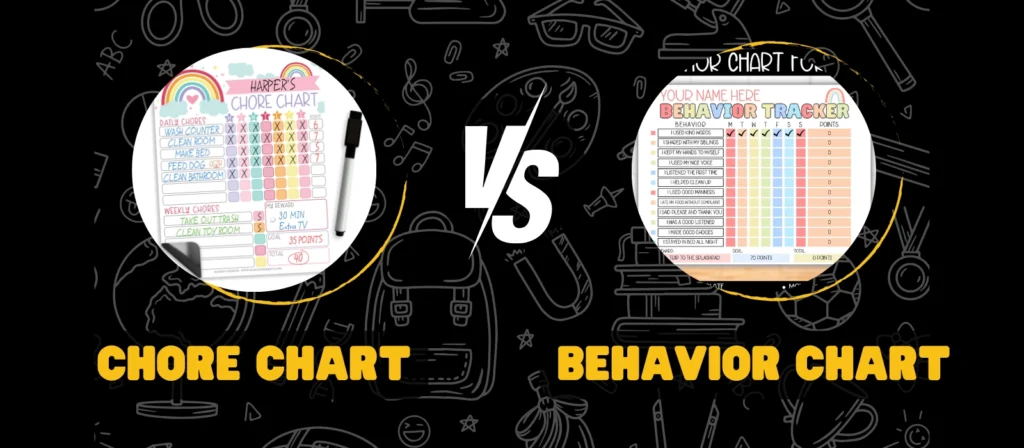
What Is a Chore Chart and Behavior Chart for Kids?
A chore chart and behavior chart for kids are visual organizational tools designed to guide and reinforce positive habits in young children. At their core, both types of charts serve the same foundational purpose: they clearly outline expected behaviors or tasks and provide a visual way to monitor whether those expectations are being met. While a chore chart focuses on daily responsibilities like cleaning up toys, putting away classroom supplies, or helping with group tasks, a behavior chart emphasizes actions such as sharing, listening, following rules, or showing kindness.
In kindergarten settings, these charts are especially valuable. Children at this age thrive on routine and repetition, and charts give them a sense of ownership and clarity. For example, a sticker chart or star chart allows teachers to reward children in real time for demonstrating good behavior, reinforcing the value of their actions. Over time, these charts evolve into systems of accountability that help children internalize expectations and feel proud of their achievements.
There are several forms these charts can take. Some are printed and laminated, hung on the classroom wall, and updated with stickers, clips, or smiley faces throughout the day. Others might be interactive boards or magnetic panels. They may include weekly, daily, or even hourly tracking sections. A behavior chart for pre-K may include images and colors to help non-readers follow along, while a chore calendar for older children can incorporate more detailed checklists and written goals.
The goal isn’t perfection—it’s progress. When used consistently and positively, chore charts and behavior charts for kids become foundational elements of classroom management. They encourage students to become active participants in their own growth, reduce disruptive behaviors, and lighten the emotional burden on teachers by making expectations and consequences transparent and predictable.
Why Use Chore Charts and Behavior Charts in Kindergarten?
Kindergarten is a critical period in a child’s development where they learn to navigate social environments, follow routines, and begin taking responsibility for their actions. Chore charts and behavior charts are powerful tools that help facilitate this growth by turning abstract expectations into visible, achievable steps. These charts provide consistency and structure, which are essential for young children who are just beginning to understand boundaries and consequences.
A well-designed behavior chart for kindergarten supports emotional development by helping children understand the link between their actions and outcomes. For example, when a child sees that helping a friend or cleaning up earns them a smiley face or star on the chart, they begin to associate positive behavior with positive reinforcement. This simple association builds the foundation for intrinsic motivation and self-discipline.
Chore charts also encourage the development of responsibility and accountability. Tasks like organizing school supplies or assisting with classroom cleanup may seem small, but they teach children important life skills. These tasks foster independence and self-esteem, especially when the child can visually track their contributions on a chore board or chart calendar.
Moreover, these charts help teachers and caregivers manage the classroom more efficiently. When expectations are clearly displayed, children are less likely to test boundaries, and adults spend less time correcting misbehavior. This fosters a calmer, more productive learning environment.
Studies in early childhood education consistently show that visual cues, repetition, and positive reinforcement are effective strategies in behavior shaping. When used in tandem, chore charts and behavior charts not only guide behavior but also nurture emotional intelligence, resilience, and cooperation among peers.
By incorporating chore and behavior charts into your classroom strategy, you’re equipping children with tools they’ll carry throughout their lives—tools for goal setting, time management, responsibility, and social development.
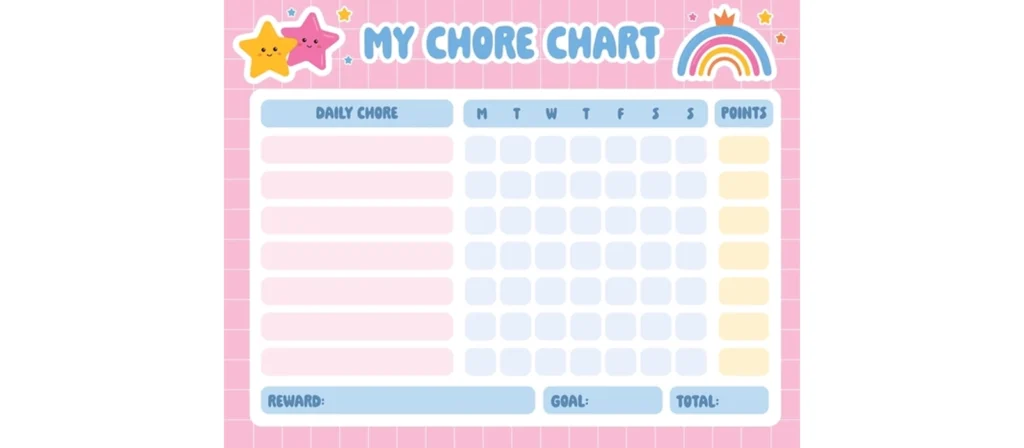
Core Components of an Effective Chart System
Designing a chore chart and behavior chart that actually works requires more than colorful paper and smiley face stickers. An effective system relies on thoughtful structure, age-appropriate content, and clearly defined goals. Below are the essential components that must be considered to ensure your charts support both classroom management and child development.
1. Clear Objectives and Expectations
Each chart should define what behaviors or tasks are being tracked. Whether it’s sharing with peers, cleaning up after art time, or waiting one’s turn during activities, each goal must be specific and age-appropriate. Ambiguous items like “be good” or “try harder” don’t provide actionable guidance. Instead, opt for phrases like “Raise hand before speaking” or “Put away your materials after use.”
2. Visual Appeal and Simplicity
Charts for kids must be visually engaging. Use bright colors, fun images, and large print. For younger children or pre-readers, include icons or illustrations alongside the text to help them understand what each row or column represents. Stickers and symbols are vital—many classrooms use smiley faces, stars, or themed graphics (like animals or weather) to reinforce comprehension and excitement.
3. Consistent Tracking System
Whether you’re using a weekly behavior chart or a daily sticker chart, consistency in tracking is key. Decide on a system: will it be daily checkmarks, sticker placements, or color-coded clip charts? Make sure children understand how it works, and stick to the routine. A predictable system builds trust and helps students internalize the structure.
4. Age-Appropriate Reward System
Not all children are motivated the same way. For some, a sticker is enough; others may need a larger incentive. Consider implementing a tiered reward system. For example:
- 3 stickers = verbal praise
- 5 stickers = extra recess
- 10 stickers = a take-home reward or certificate
This gives children short-term and long-term goals, helping sustain motivation. The system should emphasize positive behavior reinforcement, not punishment.
5. Involvement and Ownership
Children are more invested when they participate in the process. Let students place their own stickers or move their own clips. Involve them in setting goals or selecting rewards. When children feel ownership over their chart, it becomes a personal tool rather than a top-down directive.
6. Flexibility for Individual Needs
Every child is different. A one-size-fits-all chart may not address every student’s behavior challenges or learning style. Create room for flexibility—some children may benefit more from individual behavior sheets or personal star charts, while others thrive on group charts. Behavioral charts for students with ADHD or anxiety might include visual timers or fewer categories.
7. Feedback and Communication
Regular feedback helps reinforce behavior change. Whether through morning meetings, end-of-day check-ins, or parent communication folders, make chart progress visible. Many schools also integrate charts with parent-teacher communication apps to show progress at home.
When implemented with care and consistency, these core components elevate a simple classroom management tool into a transformative educational system. The right chore and behavior charts will not only guide your classroom but also nurture essential life skills for each child.
How to Set Up a Chore Chart and Behavior Chart in the Classroom
Implementing a chore chart and behavior chart system in a real classroom setting involves more than posting a printout on the wall. To be successful, the setup must be thoughtful, child-centered, and tailored to the age group and classroom environment. Here’s how to structure your setup process for success.
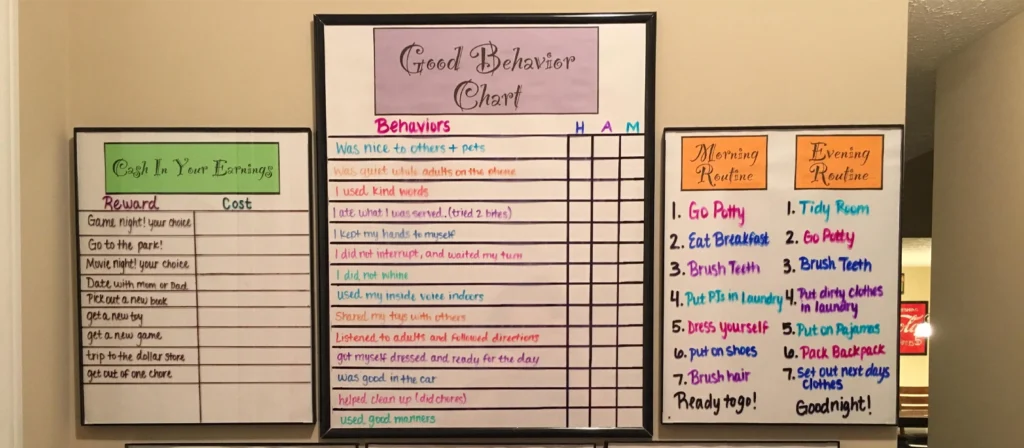
Choose the Right Location
Place the chart in a spot where children can easily see and interact with it. It should be at their eye level to encourage engagement and autonomy. Wall-mounted magnetic boards, Velcro displays, or laminated poster charts near the entry door or classroom meeting area work best. Keep the space tidy and dedicated solely to tracking behavior and responsibilities.
Decide Between Individual and Group Charts
Some educators prefer a group chore chart to promote teamwork, while others opt for individual charts to track personal progress. You can even do both—a group responsibility chart for daily cleanup tasks and personalized behavior sticker charts for social-emotional goals. Consider your classroom size, time constraints, and students’ developmental needs.
Prepare Materials and Visuals
Gather tools such as:
- Stickers, smiley faces, or laminated icons
- Clothespins or clips with students’ names
- Dry erase markers for reusable charts
- Laminated task cards for reordering tasks easily
Keep visuals colorful and age-appropriate. If needed, download free printable templates or use software like Canva or Adobe Express to design custom layouts.
Explain the System Clearly to Students
Set aside time to introduce the chart to the entire class. Walk them through the process: how they earn marks, what rewards are tied to their behavior, and what the expectations are. Use examples and role-playing to reinforce understanding. Display a sample chart showing what a completed task chart picture looks like.
Build the System into Daily Routines
Reinforce chart use during morning meetings, transitions, and clean-up time. For example:
- Morning: check who is responsible for passing out materials
- Midday: give behavior reminders linked to the chart
- End of day: review accomplishments, distribute rewards or stickers
Routine builds habits, and consistent use embeds the chart as part of the classroom culture.
Monitor, Review, and Adjust
Every few weeks, evaluate what’s working and what’s not. Are students responding to the reward system? Do certain tasks need more clarity? Get student feedback, and don’t hesitate to revise categories or switch up incentives. Even rotating themes—like animal stickers one month and superheroes the next—can keep interest alive.
By creating an environment where chore and behavior charts are interactive, visible, and reinforced through daily practice, teachers empower children to take responsibility for their actions and contribute positively to the classroom community.
Chore Chart and Behavior Chart by Age Group
Children’s abilities and developmental needs change rapidly between ages three and six, so your chore and behavior charts should evolve accordingly. What motivates a three-year-old may bore a five-year-old, and what overwhelms a preschooler might be perfect for a kindergartener. Tailoring your system by age ensures that expectations are realistic, and rewards remain engaging.
Charts for 3-Year-Olds
At this stage, children are beginning to grasp the basics of routines and rules. They respond well to simple tasks and immediate rewards. Keep charts extremely visual with images, icons, and a very limited number of tasks—no more than three per day. Examples include:
- Throwing away trash after snack time
- Putting toys back in labeled bins
- Saying “please” and “thank you”
Use a daily sticker chart with large smiley faces or stars. Immediate feedback is essential—place the sticker right after the task is completed. Avoid consequences or tally systems that are too abstract for this age.
Charts for 4-Year-Olds
Four-year-olds are more independent and capable of following multi-step directions. Their behavior charts can include four or five target behaviors. Examples include:
- Washing hands after using the toilet
- Lining up quietly
- Sharing toys during center time
Charts for this group can introduce weekly tracking with rows for each day. Sticker charts and star charts remain effective, and you can begin layering in short-term rewards such as:
- A special seat during circle time
- Choosing the next storybook
Visuals are still necessary, but you can start incorporating color-coded sections and small labels.
Charts for 5-Year-Olds
Children at this age are transitioning into kindergarten. They are ready for a bit more structure and can begin to self-monitor behavior. Charts may include five to seven target goals and can span an entire week. Task examples include:
- Completing morning routines independently
- Staying on task during activities
- Being kind to classmates
This is a good age to introduce clip charts, behavior logs, or behavior consequence charts that help students reflect on their actions. A chore reward chart can also encourage responsibility by tracking tasks like helping pass out materials or organizing classroom bookshelves.
Charts may also include a goal-setting component: “I want to earn five stars to have lunch with the teacher.” Pairing visual incentives with goal language encourages self-regulation.
Charts for 6-Year-Olds
Six-year-olds are typically in full-day kindergarten or first grade. They are ready for deeper reflection and delayed gratification. Their charts can include more nuanced behaviors and flexible systems. Consider:
- Weekly behavior charts with specific, measurable outcomes
- Color charts or point-based charts with rewards at the end of the week
- Sticker charts with bonus boxes for going beyond expectations
Encourage student involvement in designing or updating their own charts. They can write their names, circle goals, or reflect with teachers about what went well.
At every age level, behavior and chore charts work best when tied to clear, meaningful communication and reinforcement. Tailor systems to be developmentally appropriate, and adjust as the child’s understanding and independence grow.
Common Chart Formats and Templates to Use
Not all behavior and chore charts are created equal. Different goals, age groups, and classroom environments call for different formats. Choosing the right type of chart can increase engagement, improve clarity, and make tracking more efficient. Below are the most popular chart formats used in kindergartens, along with examples and resources for free downloads.
1. Sticker Charts
Sticker charts are one of the most common and effective forms, especially for younger children. Kids earn a sticker each time they demonstrate a desired behavior or complete a task. Once a set number of stickers are earned, they receive a reward. These are highly visual, easy to use, and provide instant gratification.
Recommended for: Ages 3–5
Common uses: Sharing, clean-up tasks, listening
2. Star Charts
Star charts function similarly to sticker charts but are often used with older preschoolers who can grasp cumulative rewards. Stars may be drawn, pasted, or stamped and are collected toward a larger goal. You can use gold stars to signify exceptional behavior.
Recommended for: Ages 4–6
Common uses: Morning routines, homework preparation, task completion
3. Behavior Clip Charts
Behavior clip charts use clothespins or clips labeled with children’s names that move up or down a color-coded chart throughout the day. This format provides real-time feedback and allows children to correct their behavior and move back up. However, some educators caution against publicly displaying negative behavior.
Recommended for: Ages 5–6
Common uses: Rule-following, classroom behavior
4. Weekly and Daily Behavior Logs
These formats allow for structured reflection over time. Teachers or children can fill out sections noting behavior throughout the day or week. Often includes a section for parent-teacher communication and child self-assessment.
Recommended for: Ages 5–6
Common uses: Reflection, parent involvement, progress tracking
Free resource: Free Printable Daily Behavior Chart
5. Responsibility and Chore Calendars
Chore calendars function like mini task managers. They include small icons for duties like wiping tables, feeding class pets, or organizing supplies. Students check off tasks daily or weekly, often as part of a rotating responsibility system.
Recommended for: Ages 4–6
Common uses: Classroom jobs, cooperative responsibilities
Free resource: Printable Chore Calendar for Kids
6. Incentive Charts and Reward Trackers
These are flexible templates that track a child’s progress toward a personalized reward. They often include a points system or a goal-setting section and may allow the child to choose the reward once a target is reached.
Recommended for: Ages 3–6
Common uses: Task persistence, goal completion, positive reinforcement
Free resource: Printable Reward Tracker
Whether you choose a simple sticker chart or a multi-layered reward calendar, be sure it aligns with your teaching goals and student needs. Rotate templates occasionally to maintain novelty and engagement.
How to Keep Kids Motivated with the Chart System
While setting up a chart is important, maintaining student interest and participation over time is the real challenge. To ensure long-term success, chore charts and behavior charts for kids must remain fresh, meaningful, and emotionally rewarding. Here are proven ways to keep motivation high in kindergarten classrooms.
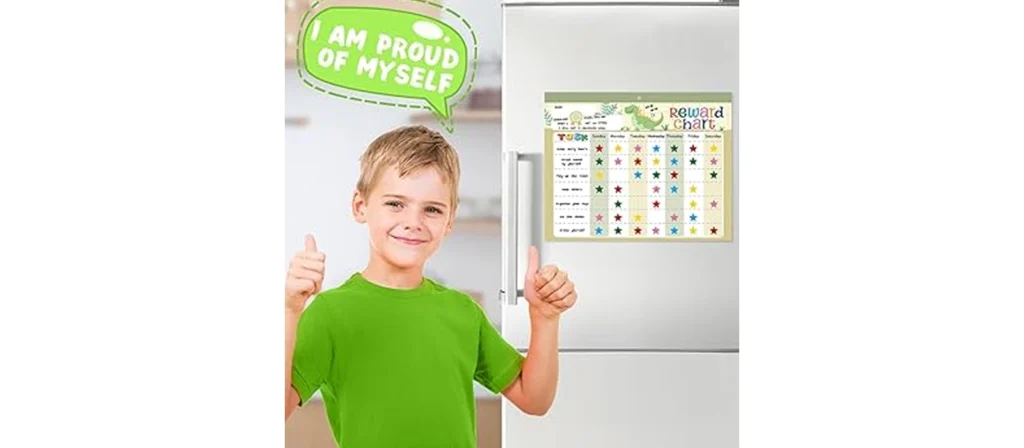
Use Varied and Personal Rewards
Not all children are motivated by the same things. Offer a mix of tangible and intangible rewards:
- Tangible: stickers, small toys, certificates, snacks
- Intangible: extra play time, line leader role, choice of class activity
Let children choose their preferred rewards from a visual menu. This increases engagement and helps them feel in control of their behavior goals.
Celebrate Small Wins Frequently
Instead of waiting for the end of the week, recognize effort daily. Even small accomplishments—like sharing a toy or helping a classmate—deserve recognition. This keeps morale high and reinforces daily engagement with the chart system.
Gamify the Experience
Incorporate elements of play, such as:
- Earning points to unlock a class-wide goal
- Using themed reward charts (superheroes, animals, outer space)
- Turning chart updates into a mini ceremony during circle time
Gamification turns responsibility into an adventure, making charts feel exciting rather than routine.
Keep Visuals Fresh and Dynamic
Rotate chart themes every few weeks. Use seasonal illustrations, holiday stickers, or change reward icons. This keeps students visually stimulated and prevents boredom with the system.
Involve Parents in the Process
Send weekly summaries home or use apps to share chart progress with parents. When families acknowledge and support positive behavior, children feel reinforced in both settings. You can also create home versions of charts to align classroom and family expectations.
Use Encouraging Language and Tone
A simple comment like “You earned this because you were helpful” has a greater impact than a generic “Good job.” Children thrive on specific praise, and linking it directly to chart goals reinforces the connection between actions and rewards.
Adjust the System Over Time
As children grow and mature, their motivations and abilities evolve. Periodically reevaluate your chart system:
- Are goals still age-appropriate?
- Are rewards still motivating?
- Are students still engaged?
Solicit feedback from children and co-teachers to fine-tune your system for continued effectiveness.
By continuously adapting and positively reinforcing the use of chore charts and behavior charts, teachers can sustain student engagement, build confidence, and foster a growth-oriented classroom culture.
Mistakes to Avoid with Behavior and Chore Charts
Even the most well-intentioned chart systems can fall short if they are not thoughtfully implemented or regularly evaluated. Avoiding common pitfalls will help ensure that your behavior and chore charts actually support learning, rather than becoming a source of confusion or frustration.

1. Setting Vague or Unrealistic Goals
Statements like “Be good” or “Behave better” are too ambiguous for young children. Charts should include specific, observable actions such as “Use quiet voices indoors” or “Put away three toys.” Similarly, avoid setting goals that are beyond a child’s developmental stage. If a 3-year-old is expected to track behavior over an entire week, they may lose interest or become discouraged.
2. Inconsistency in Implementation
One of the most common mistakes is failing to use the chart consistently. If children can’t predict when the chart will be updated, they lose trust in the system. Whether you track daily, weekly, or in real time, stick to the schedule and update regularly. Consistency is essential to maintaining motivation and clarity.
3. Overemphasis on Punishment or Public Shaming
While behavior clip charts can be helpful, using them to highlight negative behavior publicly can harm a child’s confidence. Avoid systems that shame or single out children. Instead, redirect focus toward positive behavior reinforcement. If you must address poor behavior, do it privately and constructively.
4. Using Rewards That Lose Impact
If the same sticker or small toy is offered repeatedly, children may lose interest. Rotate rewards and involve kids in selecting new ones. Likewise, avoid relying solely on material incentives—balance with social rewards like praise, special roles, or class privileges.
5. Lack of Student Involvement
Charts should not be something that teachers control entirely. Students should have ownership—placing their stickers, tracking their stars, or helping choose rewards. When kids are active participants in the system, they are more likely to stay engaged.
6. Not Reviewing and Adjusting the System
As classroom dynamics shift, the chart system should evolve. If it’s not working—either too easy, too complex, or no longer motivating—adjust it. Gather feedback from children, parents, and other teachers, and treat the chart system as a flexible tool.
7. Ignoring Emotional and Social Context
Sometimes behavior challenges stem from stress, home life, or developmental differences. Charts should never replace empathy. Use them as supportive tools within a broader framework of understanding. Pair them with relationship-building, routines, and positive classroom culture.
By steering clear of these common mistakes, educators can ensure their behavior and chore charts remain effective, respectful, and aligned with the developmental needs of young learners.
Conclusion
Behavior charts and chore charts are more than classroom tools—they’re powerful systems for guiding young children toward independence, self-awareness, and positive social behaviors. When well-designed and used consistently, these charts help turn everyday routines into valuable teaching moments.
For educators and administrators striving to create structured, engaging, and emotionally supportive kindergarten environments, the right charting system can make all the difference.
At XIHA Furniture, we understand the importance of behavior management tools and classroom organization. That’s why we don’t just supply furniture—we support a complete early education environment. Our kid-friendly furniture solutions are designed to complement systems like behavior charts, creating spaces that are functional, safe, and inspiring for young learners.
If you’re designing or furnishing a kindergarten, contact us to discover how our one-stop solutions can support your daily routines—from storage for sticker charts to display boards for your reward systems.

